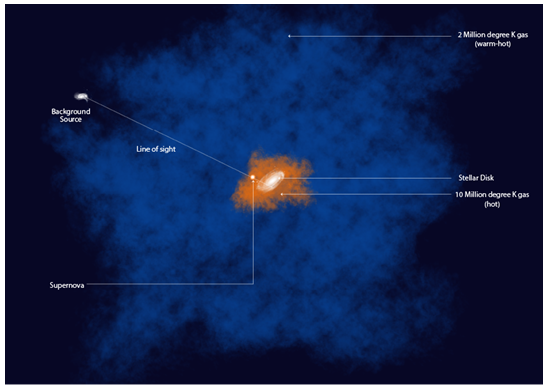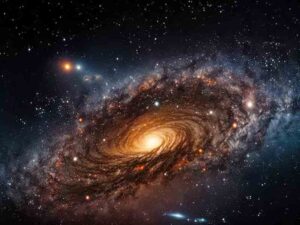New Delhi:(PIB) Scientists may have finally hit upon the possible mysterious sources that have pumped heat and kept alive the fiery hot gas which has been recently detected but has remained unexplained, so far.
There is more gas than stars in our galaxy. The prevailing, massive gas reserve is the main source for star formation in our galaxy. The availability of such abundant gas helped sustain this process till date. However, because of its tenuous nature, astronomers have found it extremely difficult to see, let alone measure the volume of this gaseous matter.
But a few decades ago, studies established the presence of gaseous matter surrounding our galaxy, the Milky Way. It was found that the galaxy was surrounded by a large sphere of gas which was a few million degrees Kelvin hot. This sphere of gas extended to 700 thousand light years. Such high temperatures, researchers said, could be associated with the gravity of the Milky Way, as atoms would have to constantly swirl around in order to rescue itself from falling prey to the galaxy’s strong gravity.
But what further intrigued the scientific community, in the more recent years, was the discovery of gaseous matter which was even hotter than what was known previously. This latest discovered gaseous matter was pitched to be around ten million degrees Kelvin. Faint X-ray emissions were found in all directions of the Milky Way that bore a strong signature of a super-hot gas. At the same time, this gas also showed up in the spectra of at least three distant quasars, as an absorbing medium.
A keenly studied research area emerged, and, since then, astronomers have been trying to find clues and links to the sources that was pumping heat and keeping alive the fiery hot gas.
Scientists at the Raman Research Institute (RRI), an autonomous institute funded by the Department of Science and Technology (DST), Government of India, along with their collaborators at IIT-Palakkad and Ohio State University, have detailed about the mysterious source through their proposed model in two related studies.
They have confirmed that the gas responsible for emitting and absorbing the signals detected by astronomers were not the same. Instead, the X-ray emitting hot gas was caused by a puffed-up region around the stellar disc of the Milky Way. Since there is a continuous on-going star formation at various regions across the disk of the Milky Way, the massive stars in these regions explode as supernovae, and heat the gas around the disk to high temperatures.
“As such, explosions keep heating up the gas floating around the disc of the Milky Way and they enrich the gaseous matter with elements synthesized within massive stars,” said Mukesh Singh Bisht, PhD student at RRI.
As this turbulent gas is swept up from the disc and swirls around violently, it either escapes into the surrounding medium or cools and falls back onto the disc.
In the case of absorption studies, along with the superhot temperatures that the vast gaseous matter possessed, its elemental composition, too, surprised the astronomers. This absorbing hot gas was found to be enriched with α-elements.
“This fiery gas, at least in a few directions, seems to be enriched with large quantities of α-elements, such as Sulphur, Magnesium, neon etc., whose nuclei are nothing but multiples of Helium nuclei. This is a vital clue of nuclear reactions occurring within the stellar core. These elements are thrown out of massive stars during supernovae explosions,” explained Biman Nath, faculty, RRI, and one of the contributory authors in both the papers.
Even though there are thousands of run-away stars that get constantly ejected out of the Milky Way disc, when some of them which may hover above the stellar disc explode as supernovae, they potentially create a puff of α-enriched and fiery gas around them.
“If they fall in line with the direction of distant sources of light quasars, the atoms in this hot gas would absorb and produce shadow signals, thus explaining the absorbing hot gas. At the same time, a veil of fiery hot gas keeps engulfing the Milky Way disc, as a result of the star forming activities in the stellar disc of the Milky Way which explains the hot gas seen in X-ray emission,” said Bisht. The study was published in the Astrophysical Journal.
The faint X-ray signals thus produced could be further studied to obtain more clues. The group plans to test the models in other frequencies.

Figure caption: This illustration shows the various components of the Milky Way. The spiral features at the centre represent the stellar disc. The stellar disc is surrounded by the newly discovered very hot gas in emission with puffed-up disc like structure. The blue region marks the extent of the two-million degrees Kelvin gas. The white line shows the direction along a background source (a quasar). Along this direction, a supernova from runaway star is shown with a bright blob which explains the absorption by the very hot gas.





